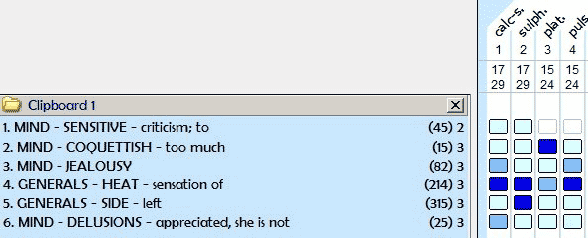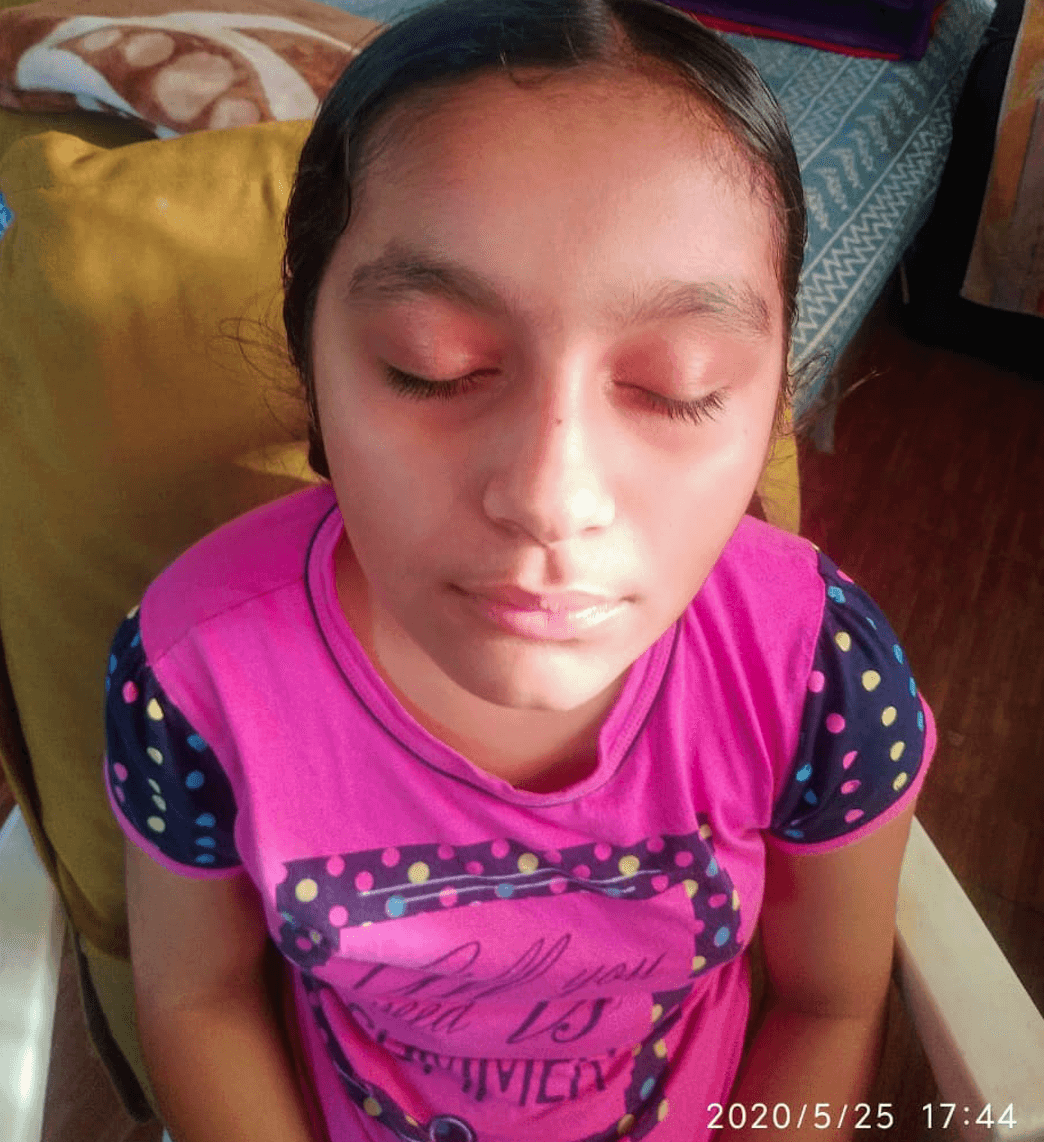Little Bandhura* is four years old and she has had vitiligo for six months. This is her chief complaint and it was first noticed in the centre of the nape of her neck. It then gradually spread to her face and the upper eyelid of her left eye. Her mother is keen to pursue homeopathy because vitiligo (which may be an autoimmune disease) is known to be hard to treat. Also, some other treatments can have unwanted side effects.
Her treatment started on 28th May 2012, and she was 4+ yrs old at that time. Regular follow-ups were completed every month from then until 29th May 2013, when all the patches had disappeared.
This case was first written up in 2017. Now after a follow up last month on 25th May 2020, we have edited this article to include an 'after' photo at 12+ yrs old, which you can see at the end of the blog. Happily there is total resolution of the patches involved at the neck, eyelids and upper chest area. These days Bandhura is a studious and very obedient child. The only concerns are that she gets a seasonal cold once a year.
It has been nearly 5 years without recurrence.
More research is needed about the causes of vitiligo. Some writers say that a single event such as sunburn or emotional distress can be a cause. It is important that distress and stressful events are covered in the homeopathic case taking questions.
When Bandhura's mother is questioned about her pregnancy, she says that her husband was a bit rude and abrupt in his behaviour and also she had wanted a male child. The pregnancy had nothing remarkable happen and Bandhura was born by C section because her mother had no labour pains.
Next, Bandhura's mother is asked to describe her child. At four years old, Bandhura will never step outside if she is not properly dressed. All round, she is a sensitive child, and on further probing the parents told me much about this. Bandhura wants to draw and colour in so much, that they don’t need to push her to do any activities because she does it by herself. She loves to hold a pen and scribble on her own and she is very interested in getting a positive opinion about her work. “I did everything well and I do good in my work and my teacher often appreciates me for my drawings.” I asked further about how Bandhura reacts if you appreciate others or things not related to her and the parents replied "She gets upset very easily if we appreciate someone else, she will immediately go inside and get her workbooks and say, "Look I got stars here".
Likewise she is a very good in her selection of clothes and accessories and loves to wear makeup and ribbons to match her clothes. This is to the extent that she would never step outside if she is not properly dressed with matching accessories. (Remember that she is four years old).
Bandhura is an only child. Whenever a cousin or another child visits her home and gets due attention, it upsets her, because she likes all the attention for herself. And as for her sensitivities, if someone talks to her in a rude manner or if she sees her parents fighting with each other, she starts crying. If her father corrects her or points out anything to her, especially in front another child, then she gets offended and secludes herself until her father comes to her and apologizes. On asking closely about this, it is not her father pointing things out to her which upsets her, but only if it is done in front of someone else. “You can tell me if I am wrong but not in front of anyone. What would they think of me?"
Fears? Not much, only if someone shouts at her or when she has to go to another room alone, at night.
The vitiligo has no numbness or other sensation.
As for physical general symptoms: she is a hot child ++, with profuse perspiration + more so on the scalp. Her thirst is increased and she likes sweets ++. The family medical history includes hypertension and asthma.
Observations: She has an oval shaped head with protruded forehead, average build, hair texture is soft; forehead is generally hairy with soft hairs and thick eyebrows. Not a very open child to strangers like me, but she responds well to questions and she had no hesitation after subsequent visits.
Vitiligo Treatment Case Analysis
Miasmatically, in this vitiligo patient, we need to treat:
- The disposition of the patient along with the cause of the change in the homeostasis
- The dominant miasm which is Sycosyphilitic. There is discoloration of the skin due to depigmentation (Sycosis miasm) due to death of the local pigment cells and due to autoimmunity (Syphilis Miasm) at the level of Endocrine System, 5th Layer as per Theory of Suppression
- Miasmatically, this disease has already already bloomed and as of now there is no use looking at the cause.
- As mentioned in the Aphorism No. 81, the two miasms Sycosis and Syphilis are nothing but developed Psora. Hence we need to take care of Psora most importantly i.e basic disposition and sensitivities
- Miasmatic analysis: Chief complaint Vitiligo - Sycosyphilitic
- To understand what a miasm is, in homeopathy read more here
Now, from the above case taking and analysis we conclude that we need a medicine which should be Hot, Left Sided, Reserved, Egoistic, Sensitive, Jealous and who needs
Appreciation. [The affected side is the left which is the direction of the spread of Vitiligo from the site of origin.] The miasmatic dominance of the medicine should be Sycosyphilitic. Here we are to consider the complete disposition and sensitivity of the patient to treat Vitiligo because it’s a systemic disease. We shall see restoration to health according to Hering’s Law of Cure in reverse order of appearance of the spots. The spots should recolour from margins to inside, not like a spot appearing in the middle of the scar, that would be the wrong direction. Vitiligo should always go in the reverse order of it’s appearance and by closing in from margins.
Rubrics which I decided to choose
A rubric is a symptom as written in the Homeopathic Repertory. Rubrics are chosen according to the symptoms of the child including the disposition and sensitivities. Bandhura is an egotistical child (if her father points out anything to her especially in front of another child then she gets offended and secludes herself until her father apologizes).
Overall she is a Sensitive child particularly to criticism and reprimands (if someone talks to her in a rude manner, “You can tell me if I am wrong but not in front of anyone. What would they think of me?"). Desires appreciation for herself (if you appreciate someone else in her presence then she gets upset very easily). Creative (she has more-than-usual-at-this-age interests in drawing and colouring). Diligent child (they don’t need to push her to work). Coquettish (she is a very good in her selection of clothes and accessories.) Jealousy (whenever a child visits and gets due attention it upsets her, she needs all the attention to herself only).
We need confirmed rubrics which cover the genetic predisposition of the child to restore her to health. The following chart shows three rubrics analysed by a homeopathy software program.

The remedy chosen is Calc sulph and on 28th May she receives one dose of 200c. Two weeks later further analysis is conducted after more rubrics are added, to confirm the remedy selection:

Why is the remedy Calc sulph selected?
The following medicines came out after repertorisation:
Nux vom: Nux vomica is surely a diligent remedy but firstly Bandhura is hot bodied and Nux is chilly. Secondly, Nux is an introverted and angry remedy. Nux only knows how to accomplish things whatever way possible. So there is no sensitivity and moreover there is no creativity in Nux Vomica, hence not the remedy.
Sulph: As is well known, Sulphur is an easy going extrovert constitution with filthy appearance which is contradictory to this child. Sulph is very close, due to it’s creativity and sensitivity, but Sulph is not a diligent constitution and their hair tends to be messy and rough rather than smooth. Sulph doesn’t pay much attention to his appearance however they may become fastidious in Sycosis. This would be more in a manner of thinking big of himself. He might dress well but somewhere we’ll able to see dirty or mismatching clothing but he himself can’t see this.
Calc fluor: Again Calcarea fluorica is a more business minded medicine with a sharp mind and lacks creativity and emotionality, because of the flouricum component in it.
Calc sulph: Calcarea sulphurica is selected as the Calcareas are the most sensitive group in the materia medica. Here, we see a combination of sensitivity and egotism along with creativity. So Calc sulph appears to be the best match for the case, carrying the sensitivity of Calcarea with ego and creativity of Sulphur. Moreover she has a bony head with introvertedness and there is a need of appreciation in Calc sulph.
The next step is to follow up. According to Hering’s law changes should be in the following manner:
- Reverse order of appearing of depigmented spots
- Spots should heal to normal from margins inward
- Sensitivities and jealousy should normalize
First Follow up:
On 11th June, there is no change in the vitiligo spots. She has a sore throat with a low grade fever for two days which subsided by itself. This is analysed as the appearance of Psoric symptoms signifying the start of the healing process, which is a good sign. The second follow up, is the 26th June and little Bandhura is better in general and her appetite has improved. A pinkish hue has appeared in the white area of the spots, which indicates improved blood circulation so she is asked to come back in one month.
On the 25th July, the size of the scattered patch on the neck started to shrink. Then at the next appointment in two months time, on the 24th September, there is normal skin colour coming through on the neck area.

Picture 1
The neck is clear by the appointment on the 3rd December. She has again fallen ill, this time with a cough due to exposure to the cold. No medicine is given at this time.
On the 30th January, in the following year, the neck is completely clear and there is reduction in the size of the vitiligo on the eyelid. See picture 2 and 3. She is not given any medicine.

Picture 2

Picture 3
4th March, there is healing of the spot on the eyelid as per Hering's Law of Cure, which can be seen below in picture 4.

Picture 4
Then in the final follow up on 29th May below we can see that the spots have completely healed up in picture 5 and 6. This has been achieved with a single dose of a single medicine: Calc sulph 200c. Here we can also see the matching ribbon!

Picture 5

Picture 6

Picture 7 (the 'after' photo) taken in 2020 where there has been no return of the vitiligo for more than 3 years. This has been an excellent natural cure for vitiligo patches.
_________________________________________________
Hering's Law of Cure
Constantine Hering, is known as the Father of American Homeopathy. He outlined what is now called “Hering’s Law of Cure.” They are guidelines which can be used to assess health history and they outline the direction of cure. They state that:
- healing migrates from the innermost parts such as lungs or emotions of the patient, to the outermost areas, such as the muscles or skin
- symptoms disappear in reverse order from which they appeared. This is not always evident in acute illness but is often observed in a chronic one
- healing proceeds from the upper part of the body to the lower part
A modern understanding of Hering's Law of Cure can be gained by reading Predictive Homeopathy Part 1—Theory of Suppression by Dr. Prafull Vijayakar. This book discusses assessing a case as per Hering's Law of Cure or animal growth axis. This is an accurate way to assess the action of a Homoeopathic remedy, to decide if the remedy is acting in the right direction or not. Dr Prafull Vijaykar says Hering's law should always be there if the selected remedy is the homoeopathic simillimum.
*Her name has been changed for privacy purposes.
_____________________________________________________________________
Edit 2/12/2017 a very promising article has been published Homeopathic treatment of vitiligo: A report of fourteen cases. Authors Mahesh S, Mallappa M, Tsintzas D, Vithoulkas G. There was a mean follow-up from treatment of 58 months. The best results were achieved in the patients who were treated in the early stages of the disease. We believe that homeopathy may be effective in the early stages of vitiligo, but large controlled clinical studies are needed in this area.
_____________________________________________________________________
Since you’re here…
More people than ever before are reading the Aurum Project blog. There is currently a surge of interest in natural therapies research. If you want to find out more about the latest cutting-edge natural medicine research and homeopathy news from Australia and the world, sign up to our newsletter. You won't regret it. It will only take a minute. Thank you. Click here to subscribe today.

Dr. Kireet Taneja BHMS PGDHHM PGDMLS graduated from Panjab University, Chandigarh INDIA and is practicing in Australia and for the last eleven years he has been practicing Predictive Homoeopathy. This is an advanced and effective approach, even useful for congenital conditions, using Dr. Prafull Vijayakar’s methods. The method includes modern medical sciences (particularly genetics, physiology, psychology and biochemistry) and combines it with classical homeopathy. Dr Kireet Taneja has also pursued a Post Graduate Diploma in Health Management and Medicolegal Systems to further serve Homeopathy. Contact: +61 452 009 460
